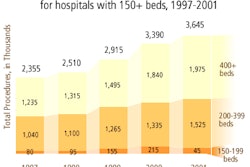The growth of digital image management and soft-copy reading has highlighted a gaping hole in the way the U.K. regulates medical imaging displays. But healthcare professionals can ensure that they are delivering quality imaging services by doing their homework before purchasing medical displays.
The imaging chain in the U.K. is adequately covered by legislation and guidelines for safety and performance from acquisition to distribution -- except for display of the image for diagnosis and reporting by a suitably qualified person.
Whether using analog (film-based) or digital-capture radiology equipment, it has long been recognized that safety and performance controls are needed to prevent undue danger to both the patient and the operator. However, national guidelines covering the use of medical displays apply only when viewing images for reporting purposes.
Why is it that one can spend in some cases millions of pounds (or dollars) on the very latest scanning equipment -- where regulations have been in place for many years -- yet fail to control the method of display?
There is currently nothing other than recommendations from various bodies, such as the U.S. Food and Drug Administration and the European International Standards Organization standards body -- and even then these are only guidelines that have been ratified by clinical colleges such as the American College of Radiology and the U.K. Royal College of Radiologists. Wouldn’t radiology be better served by a single set of guidelines?
Specifications
The DICOM 14 standard for medical displays is intended to provide a way of measuring a display to determine the accuracy and adjustment necessary to meet the grayscale difference function (GSDF).
However, the DICOM standard is not a performance or image display standard, as it does not recommend luminance range or resolution, nor does it define how images should be displayed for a given modality. So choosing a display on the basis of DICOM 14 capability does not itself provide suitable criteria for selection.
Recently a clinician at a large U.K. hospital, who preferred not to be named, complained that he could not read the annotation on some images, let alone have the sort of image quality that would allow him to make a diagnosis.
Medical displays are always going to initially be optimized for use correctly, if supplied and installed by an ethical medical device company, but most purchasers are under the misapprehension that display is an IT product. Whereas if the display is used for making a primary diagnosis, then it should be classified by the manufacturer as a medical device, as it is a necessary part of the imaging procedure.
Form and function
So purchasers need to consider other factors that should be taken into account when purchasing or specifying a display. The main factors are:
What specification is needed?
That will be determined by the purpose for which the display will be used. For example, a display that is going to be used only for the reporting of CT or MR images does not necessarily have to be as highly specified as one for reporting chest or mammography images.
Is a cathode ray tube (CRT) display or a flat-panel more appropriate?
CRTs are still cheaper than flat-panel displays, although the cost differential is rapidly diminishing. One thing to consider is which manufacturer produces the displays that fit your requirements. It is important to have a local agent for your chosen manufacturer, as future maintenance and calibration will feature heavily in your responsibilities. Also, if two images (or sets of images) require side-by-side display, will you be able to obtain matched units? It is virtually impossible to have ideal viewing conditions if two displays of differing specifications and sizes are sited together.
Environment
When you have finally chosen the displays that are appropriate for your needs (and bear in mind that this may be a mixture of types and specifications, as it will rarely be necessary to buy all top-of-the-line models) you must consider the environment where the displays are going to be sited. Fortunately, common sense takes over from physics here. Bright sunlight, inappropriate room lighting, and positioning of the displays at a height and angle suited to the reporting clinician all have to be taken into account.
A medical display that is set up correctly upon delivery will still need maintenance, and usually calibration, during its lifetime (although displays are now becoming available with built in auto-calibration).
However, if the display is classified as a medical device, then there must be a protocol to show that all efforts have been made to maintain the correct settings, and that the image quality and visual characteristics of the studies displayed remain constant.
Maintenance and calibration
The main responsibilities of the reporting clinician and the (healthcare) trust employing him or her are to ensure that the display is appropriate for the images being reported on and that the display is maintained and calibrated to the manufacturer’s recommendations, either by the manufacturer or an engineer who has been trained by the manufacturer or their approved agent.
There is still an unfortunate tendency for displays to be thought of as IT products, and therefore the best supplier is bound to be an IT company. But then you have to ask yourself: Is the trust prepared to take the risk of possible litigation when it is found that not only was a diagnosis made on a display that is not classed as a medical device, but that no thought was given to the need for this essential part of the diagnostic imaging process to be maintained and calibrated to the manufacturer’s recommended guidelines?
Medical displays are still expensive items (although, like many electronic devices, costs are dropping year after year) and cost of ownership has to be calculated. But costs should always be balanced against the potential costs and risks of using an inappropriate display. Talk to an expert -- whether it is your current specialist radiology equipment provider, your in-house medical physicist, or a colleague who has already gone through this process. In the U.K, contact the Medicines and Healthcare products Regulatory Agency (MHRA), which will assist with answers to your questions.
It takes many years of training for radiologists and radiographers to produce the perfect image; don’t spoil their efforts by using the wrong display.
By Peter StaffAuntMinnie.com contributing writer
April 16, 2004
Peter Staff is managing director of Xograph Imaging Systems, a privately owned medical imaging company in the U.K. He has more than 30 years experience in the radiology industry. Staff is also a member of the U.K. Parliament’s Associate Parliamentary Health Forum, and sits on the British Institute of Radiology’s Industry Committee.
Related Reading
CR vs. DR -- a European perspective, November 28, 2002
The parlous state of UK radiology, September 24, 2002
Do private imaging centers have a future in the U.K.? August 15, 2002
Radiology service not keeping up with routine demand in UK, August 8, 2002
UK's imaging demands exceed capacity of personnel, September 12, 2001
Copyright © 2004 AuntMinnie.com



















